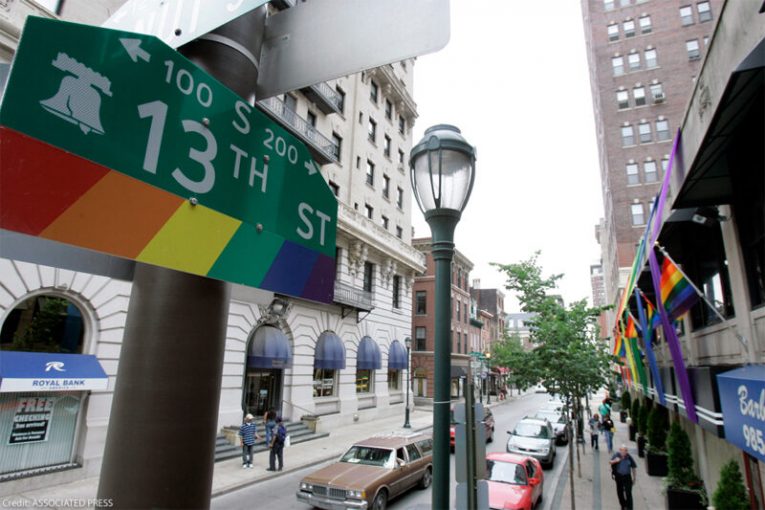

Racism continues to influence access to housing for LGBTQ communities today.
By Gillian Branstetter
For much of the last century, the “American dream” has centered on homeownership by married, white families. Alongside explicitly racist policies like racial segregation enforced by redlining, banks and realtors routinely rejected applications for mortgage loans and housing from single or divorced adults of any race, prizing the married heterosexual white man as the most “deserving” debtor and homeowner. The further away from this ideal someone happened to live — by virtue of their race, gender, marital status, or sexuality — the less likely they were to find housing outside of the country’s growing and strictly segregated urban centers.
This put many single white people — including gays and lesbians unable to legally marry — in the same housing market as Black and immigrant families, but with their white privilege firmly in hand. Following the distribution of GI grants after World War II, many white gay men found homes in city centers like Philadelphia, San Francisco, and Washington, D.C., quickly forming what are still colloquially known as “gayborhoods” — despite the presence of active queer communities within the Black and immigrant neighborhoods which long predated them.
In Washington D.C., for example, Black queer communities had long carved out a public existence under the cruel and enduring shadow of the city’s racial segregation. As early as the 1880s, former slaves such as William Dorsey Swann led drag balls in D.C. to the sensationalized criticism of the city’s white residents, a tradition sustained by the growth of the District’s literary salons and jazz renaissance during the early decades of the 1900s as led by queer poet Alice Dunbar Nelson (a reality that likewise shaped the prominence of queer artists in the more famous Harlem Renaissance). But as the growth of New Deal government agencies during the Great Depression and the military during World War II brought many gay white men to D.C., they took advantage of the city’s housing segregation and displaced many of those same communities, enforcing racial segregation even as they endured sexual segregation.
This process repeated in cities across the country, fostering the national vision of queer urban life as both very white and very male to the exclusion of queer people who were neither. This remained true even as queer people of color played a central role in organizing for queer rights, including during the 1966 uprisings at Compton’s Cafeteria in San Francisco and the more famous 1969 resistance at the Stonewall Inn in New York City. Even after the passage of the Fair Housing Act in 1968 promised the end of both racial and sexual segregation, discriminatory housing practices continued to shape queer urban life.
In the 1980s, as AIDS began to spread through queer communities across the U.S., many portrayed it as a consequence of gay men’s “promiscuity” and their failure to assimilate into that normative straight and white model of the family that realtors and banks still imagined as the ideal homeowner. As economic historian Melinda Cooper has shown, economists went so far as to argue local and federal agencies should withdraw efforts to stop the spread of AIDS in favor of prodding gay men towards marriage as a more “efficient” means of stopping the disease’s spread, integrating them into the heterosexual imperative towards homeownership and thus a more “stable lifestyle.”
In more recent decades, queer urban life has been shaped by further displacement and rising housing costs at the same time the legalization of same-sex marriage made many queer families more attractive to banks and realtors. The flight of many Black families to the suburbs has been followed by an adjacent flight of white queer people starting families and adopting the signifiers of “normalcy” and “stability” denied prior generations.
Housing discrimination against LGBTQ people still persists, particularly for transgender people. Fueled by widespread poverty, employment discrimination, and the criminalization of sex work, trans people continue to be far less likely to be homeowners and far more likely to be homeless than our cisgender peers while struggling to access low-income or even temporary housing. And as the history of LGBTQ housing shows, the present for queer people can’t be untangled from the reality of racism any more than the past.
Gillian Branstetter is an ACLU Communications Strategist

The bold text is flat-out incorrect, regarding neighborhoods like the Castro district in San Francisco. It was largely white before it changed to a predominantly “gay” neighborhood. It was NEVER a “black” or “immigrant” neighborhood – unless you’re counting groups like Irish immigrants. But last time I checked, those with Irish heritage are counted as “white”.
One might argue that the “gay” whites pushed-out the “straight” whites in that neighborhood. But truth be told, they “sold” out – at prices that would be bargains, today.
With gay men having more disposable income than “straight” families – for obvious reasons (e.g., usually no kids to support, the entire “household” consisting of workers, etc.).
And if you honestly want to explore this issue further, ask yourself if black people supported gay marriage (on average), when it was rejected in California (compared to other groups, on average).
How about if (at some point) we stop blaming white people (gay, straight, or transgender) for all of the racism and discrimination in the world? Especially when facts don’t support it?
And why not “celebrate” the relative success of gay people in places like San Francisco in the first place? Is that too much to ask? Does every instance of success need to be dragged through the “racism mud”? (What a sad, angry way of looking at the world. And one which leads to the “opposite” of success and happiness.)